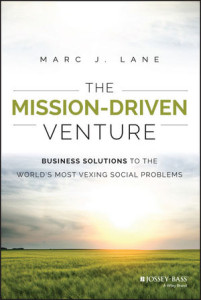In March, a living legend of social enterprise, Jerr Boschee, wrote a piece cataloging the music that defined the social justice movement. I was honored to be asked to contribute and, not surprisingly, I picked Beyoncé’s “Run the World” and Alicia Keys’ “Girl on Fire.” As I reviewed his final list and reflected on the social entrepreneurship movement that he helped start, one song stood out as the anthem for the past decade of the movement: “The Times They Are A-Changin’” by Bob Dylan.
In his new book, The Mission-Driven Venture, Marc Lane, another living legend, has beautifully documented these changes. Just as the music has evolved, so too has the movement, but its undercurrent of social justice remains true, just with a twist. As a sign of the progress made, Juma Ventures, which started in California and now has expanded to other states, provides life-changing employment to inner city youth as concessionaires at local ballparks. They taught these youth about money management and customer service skills. Remarkably, they also set up an Individual Development Account for each teenager to assist with college.
In 2011, every Bay Area youth participant in Juma Ventures graduated from high school, and now 83 percent are on track to graduate from college. Juma is just one example of many mission-driven ventures across the country that are “disrupting” the status quo and intentionally choosing to occupy the intersection between mission and money. As Marc suggests, “mission-driven ventures are helping to restore our fraying social fabric and to repair the world.”
In his book, Marc also showcases other NEW and “disruptive” strategies that are building the movement toward a more self-sufficient and accountable social ecosystem, including:
New Metrics – As we have previously noted, impact is the bottom line of the social sector. Marc illustrates how both sides are taking a hard look at metrics to ensure that each is accountable for its impact. Nonprofits have banded together to form IRIS (Impact Reporting and Investing Standards), a common language for performance. Meanwhile, B Lab has formed a certification process for for-profit organizations (We are so pleased that Social Impact Architects, a Benefit Corporation, was named last week as one of 2015 Best For the World Honorees.)
New Business Ventures – To create this impact, we have to develop new business models, which both support social goals and allow intended recipients to be a part of the solution. Marc covers the rise of microfinance and microcredit, along with the worker-owned cooperative movement, which started with Mondragon in Spain and now has roots in the United States.
New Legal Forms – For these business ventures to take root, we also have to create new forms that allow for both shareholder and stakeholder value. Considered one of the top legal experts in the United States on this topic, Marc charts the history of the variations available, including Benefit Corporations, Low-Profit Limited Liability Company and Flexible Purpose Corporations. This is a must-read for any attorney or aspiring attorney interested in social enterprise.
New Tools – The book notes that, according to the Bridgespan Group, the number of courses offered in social enterprise has doubled in the last decade. With this increase in interest, we have a number of new tools to test, start and scale ventures, including lean start-up, feasibility assessment and collaboration.
New Capital Sources – Impact investing has taken off, and with it, hope for additional capital to come to important social issues. Marc details the diverse and growing methods – including Social Impact Bonds/Pay for Success, Program-Related Investments/Mission-Related Investments, New Market Tax Credits – that are bringing Wall Street to Main Street in some exciting ways.
New Government Involvement – If we look at our social enterprise counterparts in Europe and Australia, we know conclusively that government participation and support of the movement is crucial for scale. The book delineates the sequence of events at both the federal and state levels (e.g., The Social Innovation Fund, SEEED Bill and Illinois’ Task Force on Social Innovation) that has led to the growth of the sector.
We are experiencing explosive growth in the field of social entrepreneurship, and The Mission-Driven Venture, gives us a close-up look at the change that has happened and hints at what lies ahead. It is not an academic odyssey, but is instead a practical and inspirational narrative of new strategies alongside stories of social entrepreneurs charting the path ahead. It is a chance to celebrate our successes as a movement, but also challenges us to make it easier for mission-driven ventures to make a difference in our communities. We invite you to share the strategies that have proven successful for you and invite you to join us next week as we look at change management.
Suzanne Smith is a serial social entrepreneur and bridges many disciplines as a coach and consultant to social sector organizations as Founder and Managing Director of Social Impact Architects and Co-Founder of Flywheel: Social Enterprise Hub. She also educates future social entrepreneurs as a frequent guest lecturer at campuses across the country and as Adjunct Professor at the University of North Texas and Research Fellow at the Center for the Advancement of Social Entrepreneurship at Duke University. She is also a leading author, blogger (@socialtrendspot), and top-rated speaker.


